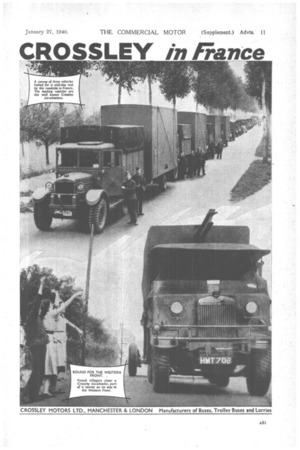Birmingham's Part in
Page 33

If you've noticed an error in this article please click here to report it so we can fix it.
Gas-vehicle Research
ACOAL-GAS-DRIVEN van owned by Birmingham Corporation, which is experimenting with coal gas as a fuel, visited Leeds last week, when Dr. J. S. Clarke, of the Birmingham Gas Department Research Laboratories, read a paper before the North-Eastern Centre of the Institution of Automobile Engineers. In the paper, entitled " The Use of Gas as a Fuel for Motor Vehicles," he outlines the results of the research carried out at Birmingham.
In his introductory remarks, Dr. Clarke points out how the possibilities of the use of town's gas for motor vehicles have been enhanced by the introduction of nickel-chrome-molybdenum steel, from which modern storage-cylinders are made. Storage capacity had been increased by the greater pressures now practicable and the serious weight handicap had been overcome.
The arrangement of cylinders and other gas equipment depended on the type of vehicle, In a typical arrangement on an Austin 20 h.p. van, the storage-system consisted of three standard-size cylinders arranged longitudinally and three shortened ones across the van, including one under the driver's seat.
Experiments carried out on many engines, states Dr. Clarke, had shown that about 90 per cent. of the power output on petrol could be obtained when using gas. The loss in power, when gas was used as a fuel, resulted in a lower acceleration, but this could he improved by increasing the compression ratio.
Outlining experiments in the use of gas as a fuel, in the light of the development of the high-speed oil engine, Dr. Clarke says it was only logical to conclude that, for ultimate success in this branch of work, an engine should be designed to suit the characteristics exhibited by gas. Therefore, about 1933 the Birmingham Gas Department, in collaboration with Messrs. Belliss and 1.14orcom, began experiments as to the application of the fuel-injection principle, the object being to ascertain the maximum compression ratio which could satisfactorily be used .before preignition occurred.
The conclusions made from these experiments, says Dr. Clarke, are :- 1) Gas consumption can be reduced by 30 per cent, when using a compression ratio of 15 to 1, compared with a ceinpression ratio of 7 to 1.
(21 Gas can be used without any sign of preignition up to compression pressures of 600 lb. per sq. in., i.e., 17 to 1 compression ratio. . 13) Spark Ignition can be successfully used with compression, pressures up to 600 lb. per sq. in.
(4) Exhaust gases admitted on Induction stroke eliminate hammering due to excessive rate of Hama propagation.
(5) Engine developed more power on gas than on oil fuel, i.e., 10.29 b,h.p. at 900 r,p.m. on gag: 8.6 b.b.p. at 900 rpm. on oil.
(6) Optimum gas-injection pressure is 20 lb.
pe(r5q.ltein. 7) T tests have demonstrated that it is impossible, with a small-bore cylinder, to obtain self-ignition of coal gas at a compression ratio of 17 to 1. This eliminates the possibility of running engines on the self-ignition
(8) The experiments have d
an engine designed to use town's gas as a fuel will compare favourably with an engine run on oil fuel, both in economy and in the power
developed.




















































































